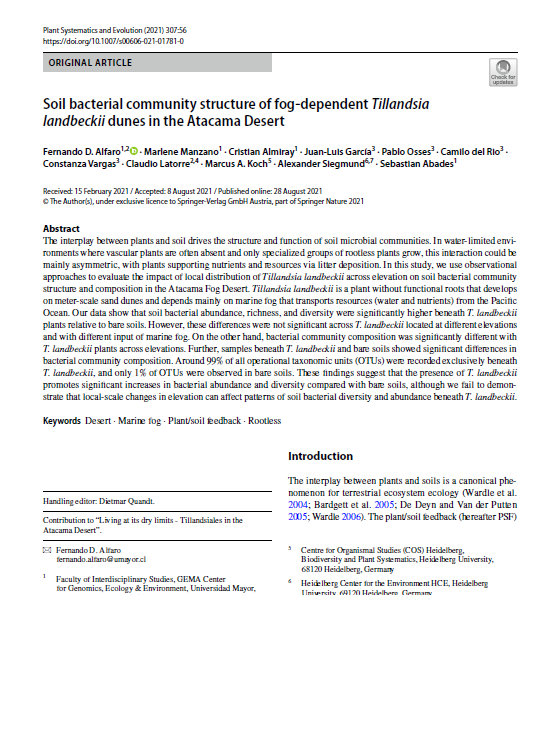Soil bacterial community structure of fog-dependent Tillandsia landbeckii dunes in the Atacama Desert

Fecha
2021-09-06Autor
Garcia, Juan-Luis
Osses, Pablo
del Rio, Camilo
Vargas, Constanza
Latorre, Claudio
Koch, Marcus A.
Siegmund, Alexander
Alfaro, Fernando D. [Univ Mayor, Fac Interdisciplinary Studies, GEMA Ctr Genom Ecol & Environm, Chile]
Manzano, Marlene [Univ Mayor, Fac Interdisciplinary Studies, GEMA Ctr Genom Ecol & Environm, Chile]
Almiray, Cristian [Univ Mayor, Fac Interdisciplinary Studies, GEMA Ctr Genom Ecol & Environm, Chile]
Abades, Sebastian [Univ Mayor, Fac Interdisciplinary Studies, GEMA Ctr Genom Ecol & Environm, Chile]
Ubicación geográfica
Notas
HERRAMIENTAS
Acceda a títulos restringidos
¿Cómo descargar?Resumen
The interplay between plants and soil drives the structure and function of soil microbial communities. In water-limited environments where vascular plants are often absent and only specialized groups of rootless plants grow, this interaction could be mainly asymmetric, with plants supporting nutrients and resources via litter deposition. In this study, we use observational approaches to evaluate the impact of local distribution of Tillandsia landbeckii across elevation on soil bacterial community structure and composition in the Atacama Fog Desert. Tillandsia landbeckii is a plant without functional roots that develops on meter-scale sand dunes and depends mainly on marine fog that transports resources (water and nutrients) from the Pacific Ocean. Our data show that soil bacterial abundance, richness, and diversity were significantly higher beneath T. landbeckii plants relative to bare soils. However, these differences were not significant across T. landbeckii located at different elevations and with different input of marine fog. On the other hand, bacterial community composition was significantly different with T. landbeckii plants across elevations. Further, samples beneath T. landbeckii and bare soils showed significant differences in bacterial community composition. Around 99% of all operational taxonomic units (OTUs) were recorded exclusively beneath T. landbeckii, and only 1% of OTUs were observed in bare soils. These findings suggest that the presence of T. landbeckii promotes significant increases in bacterial abundance and diversity compared with bare soils, although we fail to demonstrate that local-scale changes in elevation can affect patterns of soil bacterial diversity and abundance beneath T. landbeckii.
URI
https://repositorio.umayor.cl/xmlui/handle/sibum/9055https://link-springer-com.bibliotecadigital.umayor.cl:2443/content/pdf/10.1007/s00606-021-01781-0.pdf
https://link.springer.com/article/10.1007/s00606-021-01781-0
https://doi.org/10.1007/s00606-021-01781-0
Coleccion/es a la/s que pertenece:
Si usted es autor(a) de este documento y NO desea que su publicación tenga acceso público en este repositorio, por favor complete el formulario aquí.